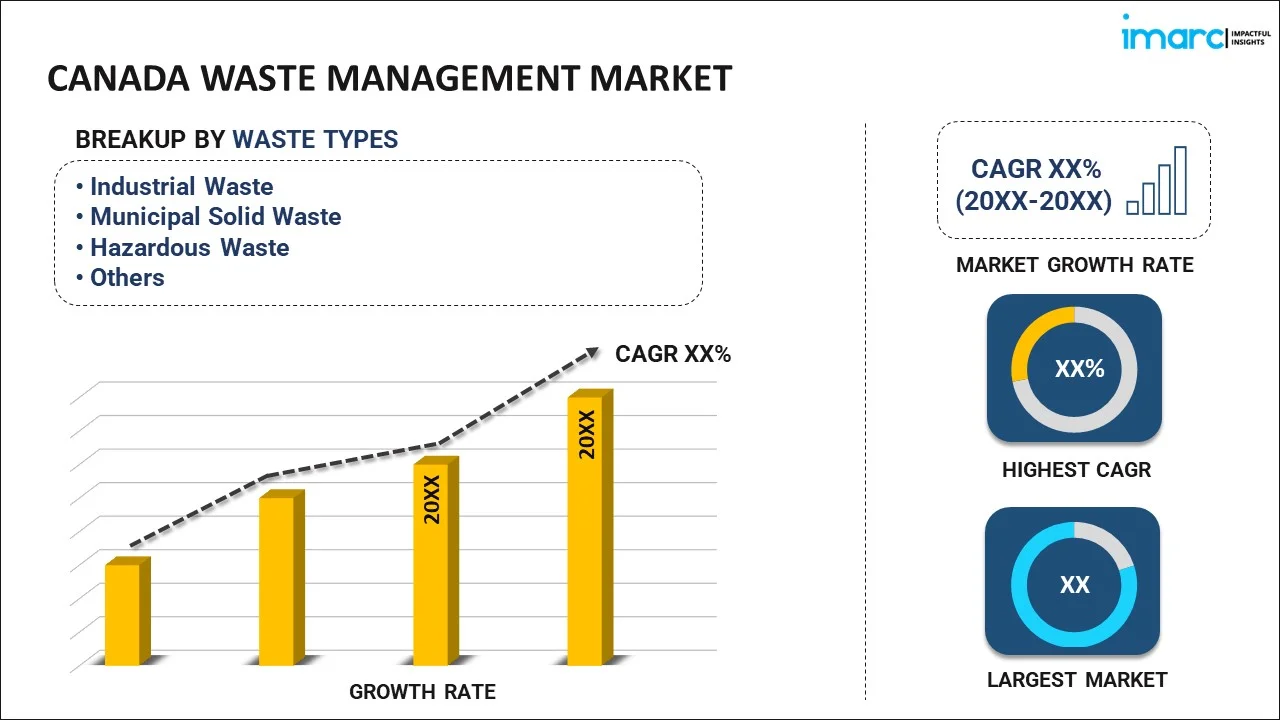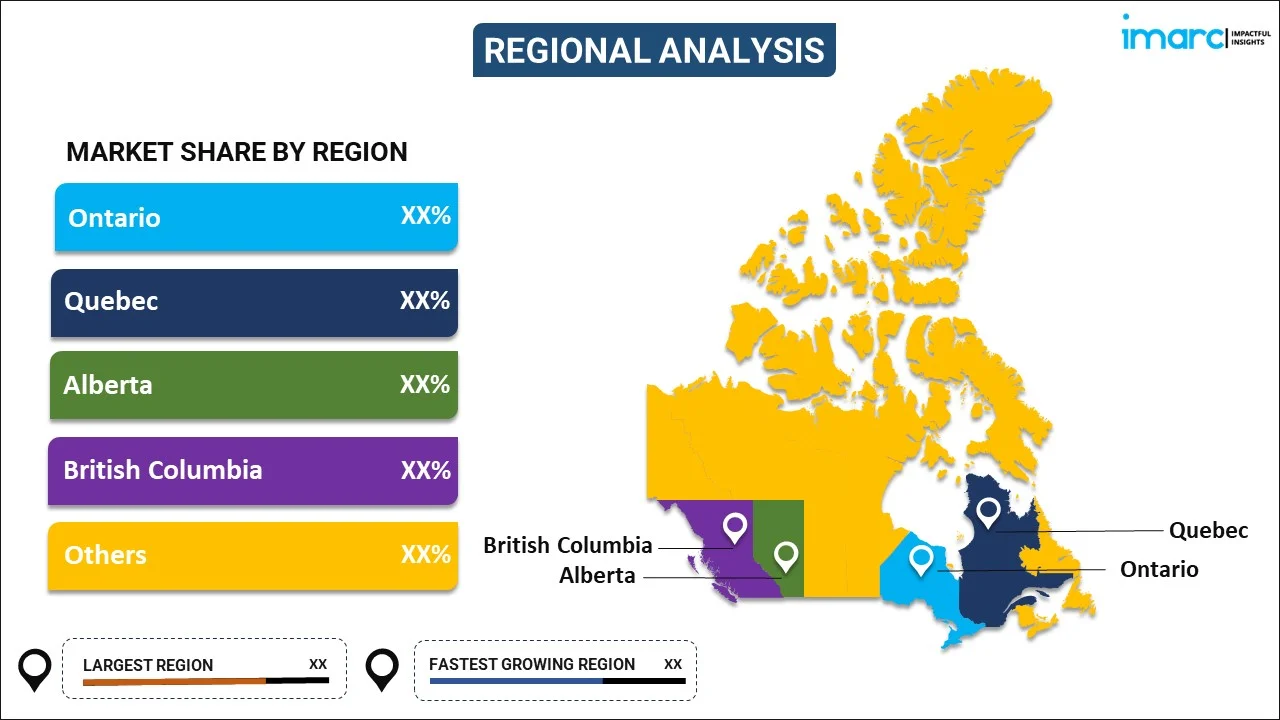
Canada Waste Management Market Report by Waste Type (Industrial Waste, Municipal Solid Waste, Hazardous Waste, E-waste, Plastic Waste, Bio-Medical Waste), Disposal Method (Landfill, Incineration, Recycling), and Region 2024-2032
Canada Waste Management Market Overview:
The Canada waste management market is projected to exhibit a growth rate (CAGR) of 5.20% during 2024-2032. The market is experiencing significant growth driven by ongoing technological advancements, rising sustainability initiatives, increased recycling efforts, and rapid expansion of capabilities by various key players through AI integration, waste-to-energy projects, and strategic acquisitions.
|
Report Attribute
|
Key Statistics
|
|---|---|
|
Base Year
|
2023 |
|
Forecast Years
|
2024-2032
|
|
Historical Years
|
2018-2023
|
| Market Growth Rate (2024-2032) | 5.20% |
Canada Waste Management Market Trends:
Increasing Adoption of Circular Economy Principles
One of the prominent trends in the Canada waste management market is the growing adoption of circular economy principles. This approach emphasizes reducing waste generation, reusing materials, and recycling waste into valuable resources. Additionally, according to the Government of Canada, in 2019, Canada launched the Canada-Wide Strategy and Action Plans on Zero Plastic Waste to encourage circular strategies such as remanufacturing, redesigning, and reducing waste. Companies and municipalities are increasingly implementing circular economy initiatives to minimize landfill usage and create sustainable waste management practices. This shift is driven by environmental concerns and economic opportunities. Businesses are recognizing that adopting circular economy principles can lead to cost savings, new revenue streams, and enhanced corporate reputation. Government policies and incentives also support this trend, promoting waste reduction, recycling programs, and extended producer responsibility schemes. This trend is expected to continue growing as more stakeholders recognize the benefits of moving toward a more sustainable and resource-efficient economy.
Technological Advancements in Waste Management
Technological advancements are transforming the waste management landscape in Canada, driving efficiencies, and improving environmental outcomes. The integration of smart technologies, such as IoT (Internet of Things) devices, data analytics, and automation, is enhancing waste collection, sorting, and processing operations. For instance, in 2022, 62.1% of enterprises in Canada adopted at least one advanced technology, with significant adoption seen in the utilities (80.5%), professional services (75.2%), and manufacturing (74.9%) sectors, as per Statistics Canada. IoT-enabled waste bins, for example, can monitor fill levels in real time, optimizing collection routes and reducing fuel consumption. Data analytics provide valuable insights into waste generation patterns, enabling better planning and resource allocation. Additionally, innovations in waste-to-energy technologies are gaining traction, converting waste into valuable energy resources. These technological advancements help in managing waste more effectively and contribute to reducing greenhouse gas emissions and supporting Canada's climate goals. As technology continues to evolve, the waste management sector is expected to see further improvements in operational efficiency and sustainability.
Expansion of Organics Recycling Programs
The expansion of organics recycling programs is another significant trend in the Canada waste management market. Organic waste, including food scraps, yard trimmings, and other biodegradable materials, represents a substantial portion of the waste stream. Recognizing the environmental impact of organic waste in landfills, where it generates methane, a potent greenhouse gas, many Canadian municipalities are expanding their organics recycling programs. The resulting compost or biogas can be used as a valuable resource for agriculture, landscaping, and renewable energy production. Public awareness campaigns and educational initiatives are also promoting participation in organics recycling programs, helping to reduce contamination and improve program effectiveness. The expansion of these programs helps in diverting waste from landfills and supports soil health and renewable energy goals. As more communities adopt and enhance organics recycling programs, the overall environmental footprint of waste management in Canada is expected to decrease. According to the Statistique Canada, in 2019, 76% of Canadian households reported composting their organic waste, up from 61% in 2009, reflecting growing participation in organic recycling initiatives.
Canada Waste Management Market News:
- In April 2023, the Government of Canada launched the Federal Plastics Registry as part of its commitment to reducing plastic waste and pollution. This new tool requires plastic producers and other companies in the plastics value chain to report annually on the quantity and types of plastics they introduce into the Canadian market and how these plastics are managed through their lifecycle.
- In October 2023, J.F. Lehman & Company acquired Heritage-Crystal Clean, Inc. for $1.2 billion. Heritage-Crystal Clean, Inc. is one of the leading providers of hazardous and non-hazardous waste disposal services.
Canada Waste Management Market Segmentation:
IMARC Group provides an analysis of the key trends in each segment of the market, along with forecasts at the country level for 2024-2032. Our report has categorized the market based on waste type and disposal methods.
Waste Type Insights:

- Industrial Waste
- Municipal Solid Waste
- Hazardous Waste
- E-waste
- Plastic Waste
- Bio-Medical Waste
The report has provided a detailed breakup and analysis of the market based on the waste type. This includes industrial waste, municipal solid waste, hazardous waste, e-waste, plastic waste, and bio-medical waste.
Disposal Methods Insights:
- Landfill
- Incineration
- Recycling
A detailed breakup and analysis of the market based on the disposal methods have also been provided in the report. This includes landfill, incineration, and recycling.
Regional Insights:

- Ontario
- Quebec
- Alberta
- British Columbia
- Others
The report has also provided a comprehensive analysis of all the major regional markets, which include Ontario, Quebec, Alberta, British Columbia, Others.
Competitive Landscape:
The market research report has also provided a comprehensive analysis of the competitive landscape. Competitive analysis such as market structure, key player positioning, top winning strategies, competitive dashboard, and company evaluation quadrant has been covered in the report. Also, detailed profiles of all major companies have been provided.
Canada Waste Management Market Report Coverage:
| Report Features | Details |
|---|---|
| Base Year of the Analysis | 2023 |
| Historical Period | 2018-2023 |
| Forecast Period | 2024-2032 |
| Units | Billion US$ |
| Scope of the Report | Exploration of Historical Trends and Market Outlook, Industry Catalysts and Challenges, Segment-Wise Historical and Future Market Assessment:
|
| Waste Types Covered | Industrial Waste, Municipal Solid Waste, Hazardous Waste, E-waste, Plastic Waste, Bio-Medical Waste |
| Disposal Methods Covered | Landfill, Incineration, Recycling |
| Regions Covered | Ontario, Quebec, Alberta, British Columbia, Others |
| Customization Scope | 10% Free Customization |
| Post-Sale Analyst Support | 10-12 Weeks |
| Delivery Format | PDF and Excel through Email (We can also provide the editable version of the report in PPT/Word format on special request) |
Key Questions Answered in This Report:
- How has the Canada waste management market performed so far and how will it perform in the coming years?
- What has been the impact of COVID-19 on the Canada waste management market?
- What is the breakup of the Canada waste management market on the basis of waste type?
- What is the breakup of the Canada waste management market on the basis of disposal method?
- What are the various stages in the value chain of the Canada waste management market?
- What are the key driving factors and challenges in the Canada waste management?
- What is the structure of the Canada waste management market and who are the key players?
- What is the degree of competition in the Canada waste management market?
Key Benefits for Stakeholders:
- IMARC’s industry report offers a comprehensive quantitative analysis of various market segments, historical and current market trends, market forecasts, and dynamics of the Canada waste management market from 2018-2032.
- The research report provides the latest information on the market drivers, challenges, and opportunities in the Canada waste management market.
- Porter's five forces analysis assist stakeholders in assessing the impact of new entrants, competitive rivalry, supplier power, buyer power, and the threat of substitution. It helps stakeholders to analyze the level of competition within the Canada waste management industry and its attractiveness.
- Competitive landscape allows stakeholders to understand their competitive environment and provides an insight into the current positions of key players in the market.
Need more help?
- Speak to our experienced analysts for insights on the current market scenarios.
- Include additional segments and countries to customize the report as per your requirement.
- Gain an unparalleled competitive advantage in your domain by understanding how to utilize the report and positively impacting your operations and revenue.
- For further assistance, please connect with our analysts.
 Inquire Before Buying
Inquire Before Buying
 Speak to an Analyst
Speak to an Analyst
 Request Brochure
Request Brochure
 Request Customization
Request Customization




.webp)




.webp)












